This post may contain affiliate links. See our affiliate disclosure.
This recipe for vegan Japanese milk bread will absolutely change the way you think about bread. It’s supremely soft and squishy, with a lightly rich and buttery mouthfeel. It’s got just the right amount of sweetness to shine in both sweet and savory contexts — from grilled cheese to French toast.
It took many attempts to perfect the texture of this vegan milk bread, but it was worth it because this dough is truly versatile and can be used to make the perfect pillowy dinner rolls, hamburger buns, and even (with a few tweaks) the best vegan cinnamon rolls. I hope you love this recipe as much as I do!

Table of Contents
What is Milk Bread?
Milk bread, known in Japan as shokupan or Hokkaido milk bread, is an Asian style of bread known for its soft, buttery texture and sweet flavor. Made with a dough enriched with eggs, milk and butter, it’s extra light and fluffy. It is somewhat similar to brioche or challah in that it can be torn apart into strands.
In traditional milk bread, the fat and lactose in milk tenderize the crumb and lend extra sweetness. Protein from eggs strengthens the dough, allowing for a higher rise and a fluffier texture. While this version is free of dairy and eggs, it doesn’t sacrifice flavor or texture. It’s every bit as rich, tender and fluffy as I remember.
Ever since perfecting this vegan Hokkaido milk bread recipe, I simply cannot go back to regular, store-bought white bread! It’s my absolute go-to for sandwiches, grilled cheese and French toast.
Ingredients
- Bread flour. Higher in gluten than regular all-purpose flour, bread flour gives the dough the structure it needs for an extra fluffy rise.
- Soy milk. To make milk bread, you need milk! Soy milk performs similarly to regular dairy milk due to its protein content and creamy texture. I like the West Life brand because it contains just two ingredients — soybeans and water.
- Active dry yeast.
- Sugar. Traditional milk bread is fluffy and sweet! The sugar in the loaf also helps it develop a beautiful golden color.
- Vegan butter. Necessary to achieve a rich texture and buttery flavor.
- Salt.
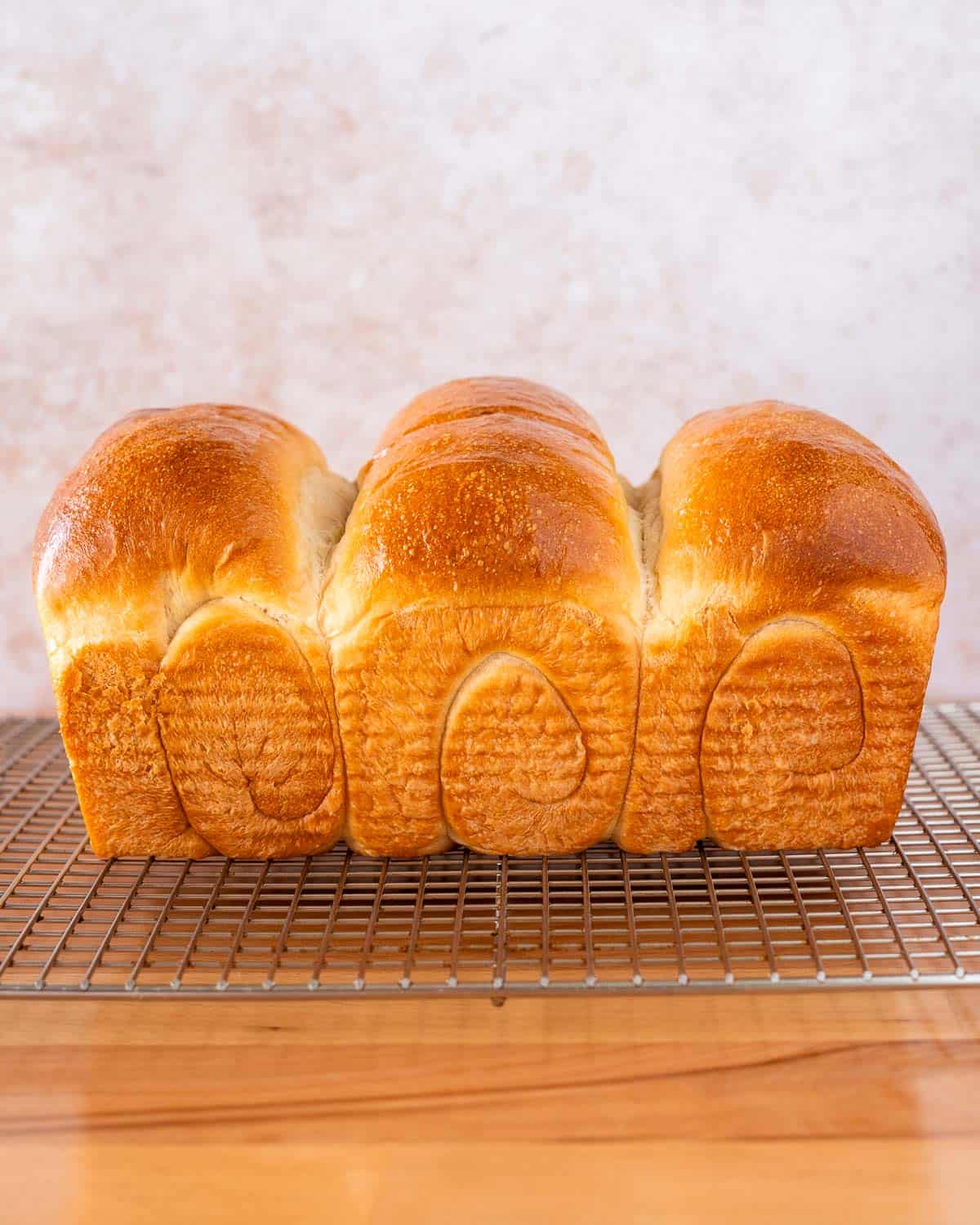

What is Tangzhong?
Tangzhong is a roux made by pre-cooking a portion of the flour and liquid (water or milk) called for in a bread recipe. The starches in the flour gelatinizes, creating a paste which is then added into the dough. This is an Asian technique used in recipes such as Hokkaido milk bread.
Tangzhong makes bread more tender and prolongs its shelf life. It also makes it easier to work with higher hydration doughs, because some of the liquid is bound up in the gelatinized starch mixture. If the same volume of flour/water were added to the dough without cooking first, the dough would be much more sticky and less workable.
Equipment You Will Need
- Small pot or pan & spatula. You’ll need this to prepare the tangzhong.
- Stand mixer with paddle & dough hook attachments. Vegan milk bread requires a lot of kneading to get that signature fluffy texture. A stand mixer makes this much easier, although you can make it by hand if needed.
- A clean work surface. I like to use a silicone pastry mat for easy cleanup, but you can also work directly on a clean counter or a marble pastry board if you have one.
- Rolling pin.
- Standard loaf tin. I find a 9×5″ loaf pan is the perfect size for this recipe. An 8×4″ can also work in a pinch, but the loaf may appear to be bursting out of it.
Additional Helpful Tools
- Danish dough whisk. If working by hand, one of these can be extremely useful! Way sturdier and easier to clean than a traditional whisk.
- Bench scraper. If kneading by hand, this will help you scrape any sticky bits of dough off the work surface. It’s also useful for dividing dough.
- Digital scale. Not totally necessary, but can be useful if you want to divide your dough into precise portions.
How to Make Vegan Milk Bread
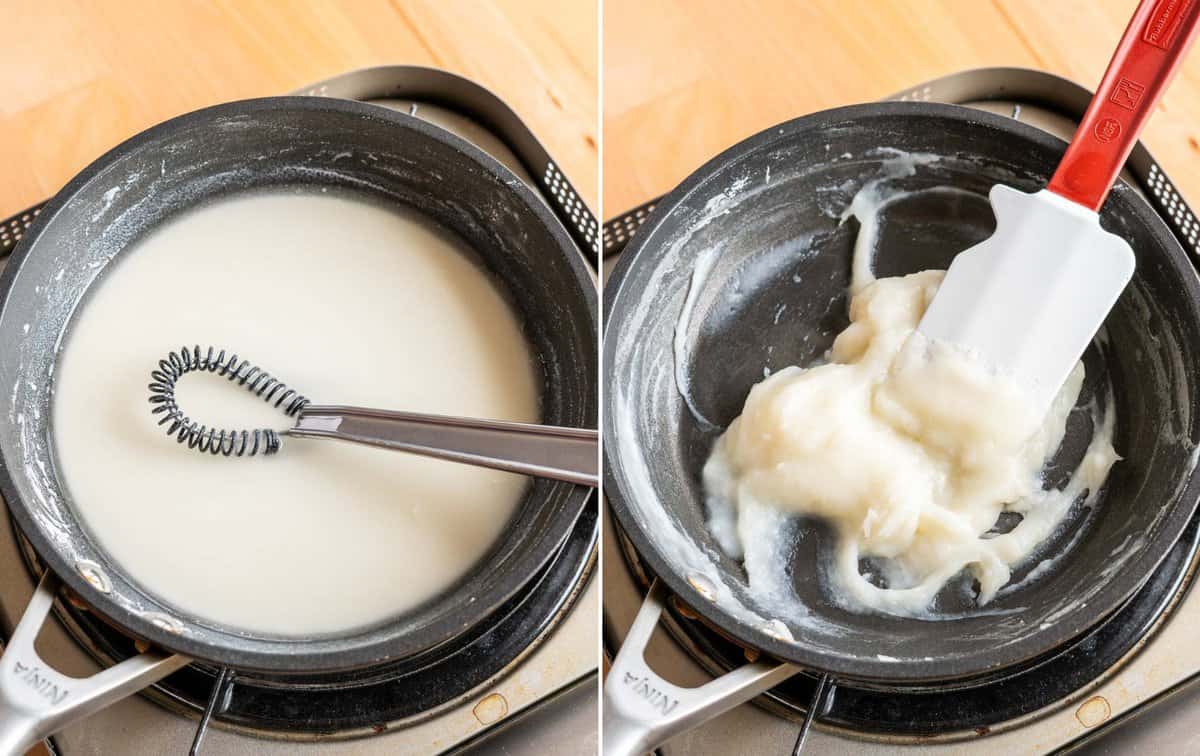
Step 1: Make the tangzhong
Whisk together flour and water. Heat, stirring constantly, until thickened to a paste consistency. Let it cool while you measure your other ingredients.
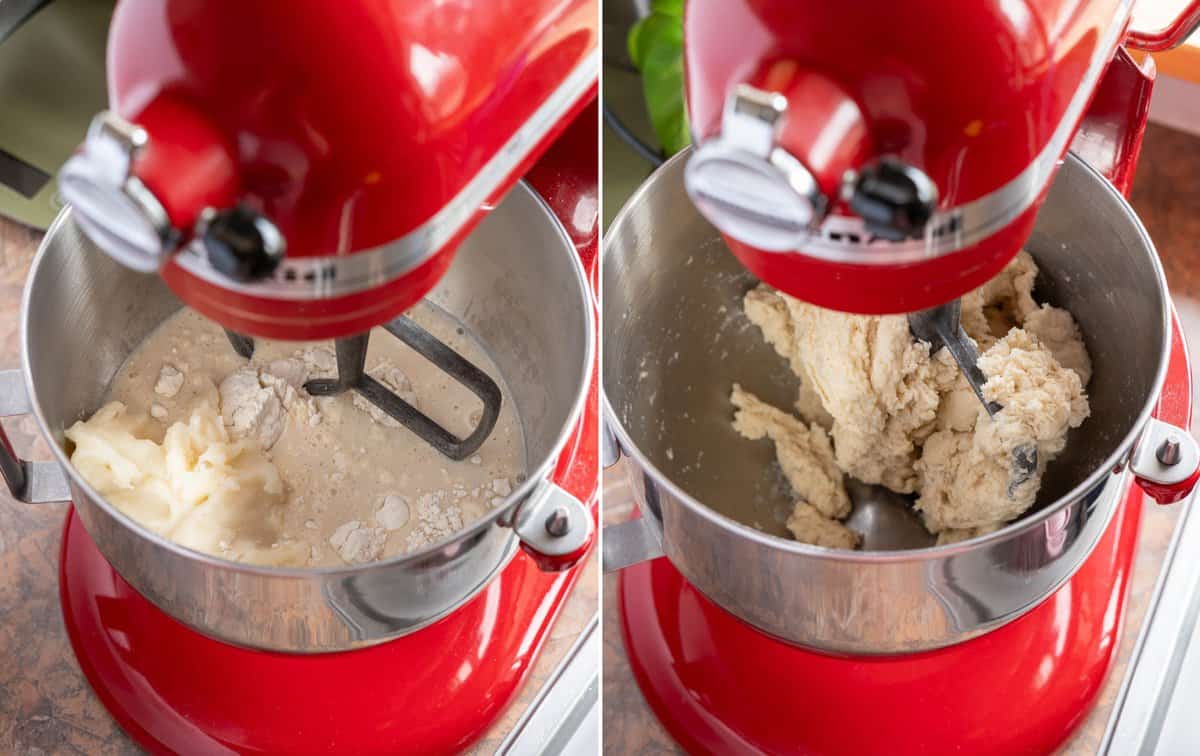
Step 2: Mix the ingredients
Add all the ingredients for the dough to a stand mixer except for the butter. Use the paddle attachment to bring everything together into a shaggy dough.
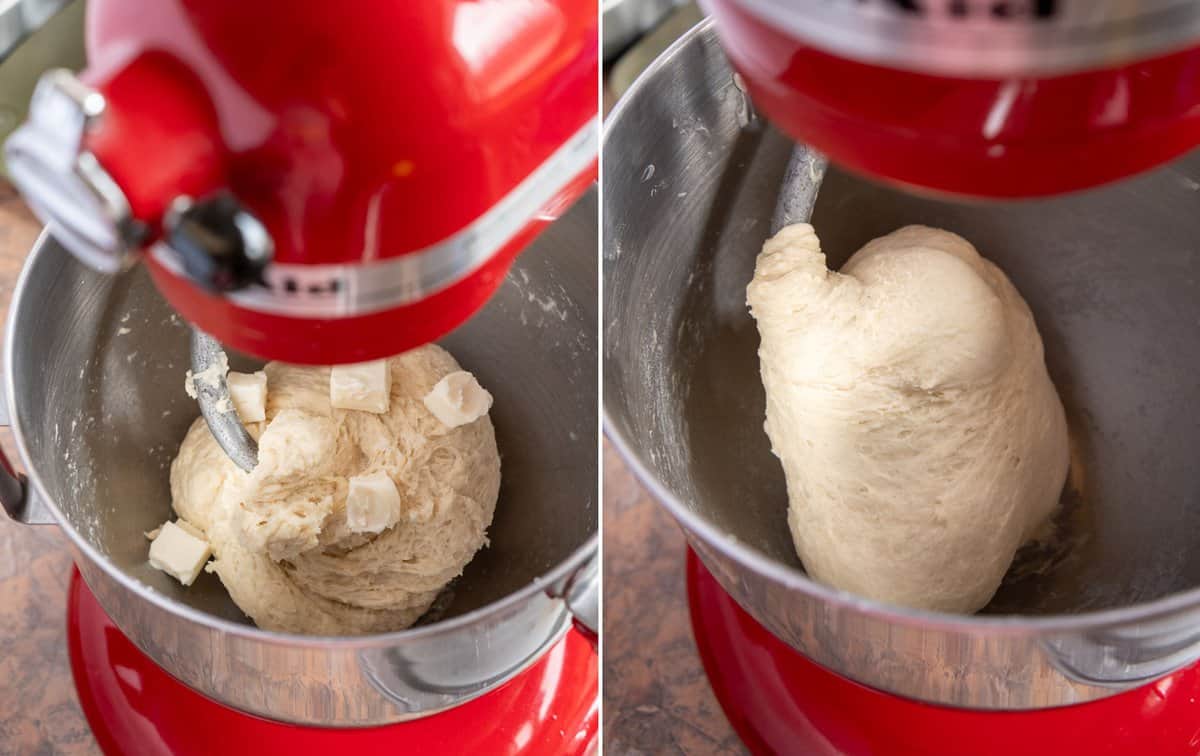
Step 3: Knead in the butter
Once the dough comes together, switch to the paddle attachment for kneading. Add in a few pieces of softened butter and knead until the butter is fully incorporated. Repeat until you’ve added all the butter. The dough will start out greasy but will gradually absorb the butter.
If the dough seems overly sticky or soft, you can work in extra flour. Add just 1 tablespoon of flour at a time and knead until fully incorporated before adding more.
The entire process can take 8-10 minutes in total. (It will take longer if you are doing it by hand.) The dough should become smooth and elastic and should bounce back when poked. It should also “clean” the sides of the stand mixer bowl.
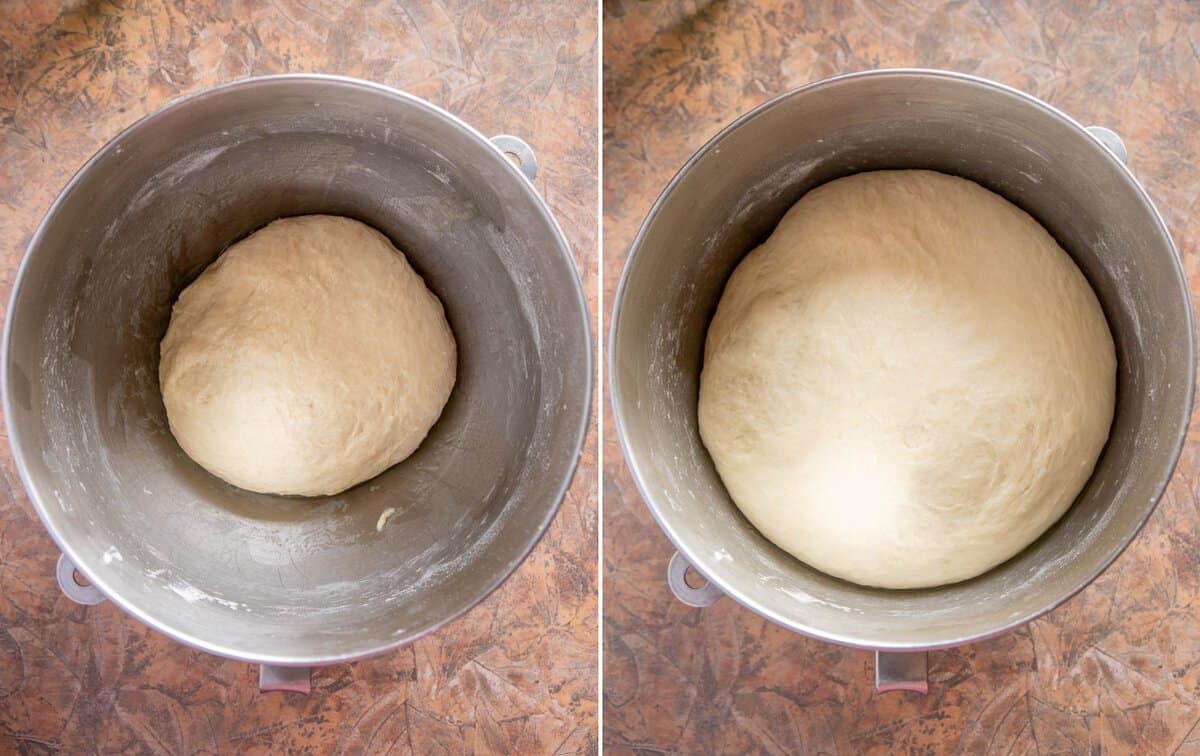
Step 4: Rise the dough
Lightly grease the bowl and allow the dough to rise, covered, until doubled in size. This usually takes about 1 hour unless the kitchen is particularly chilly — in which case it can take up to 2 hours. If you need a warm spot to rise the dough, you can place it in the oven with the light on.
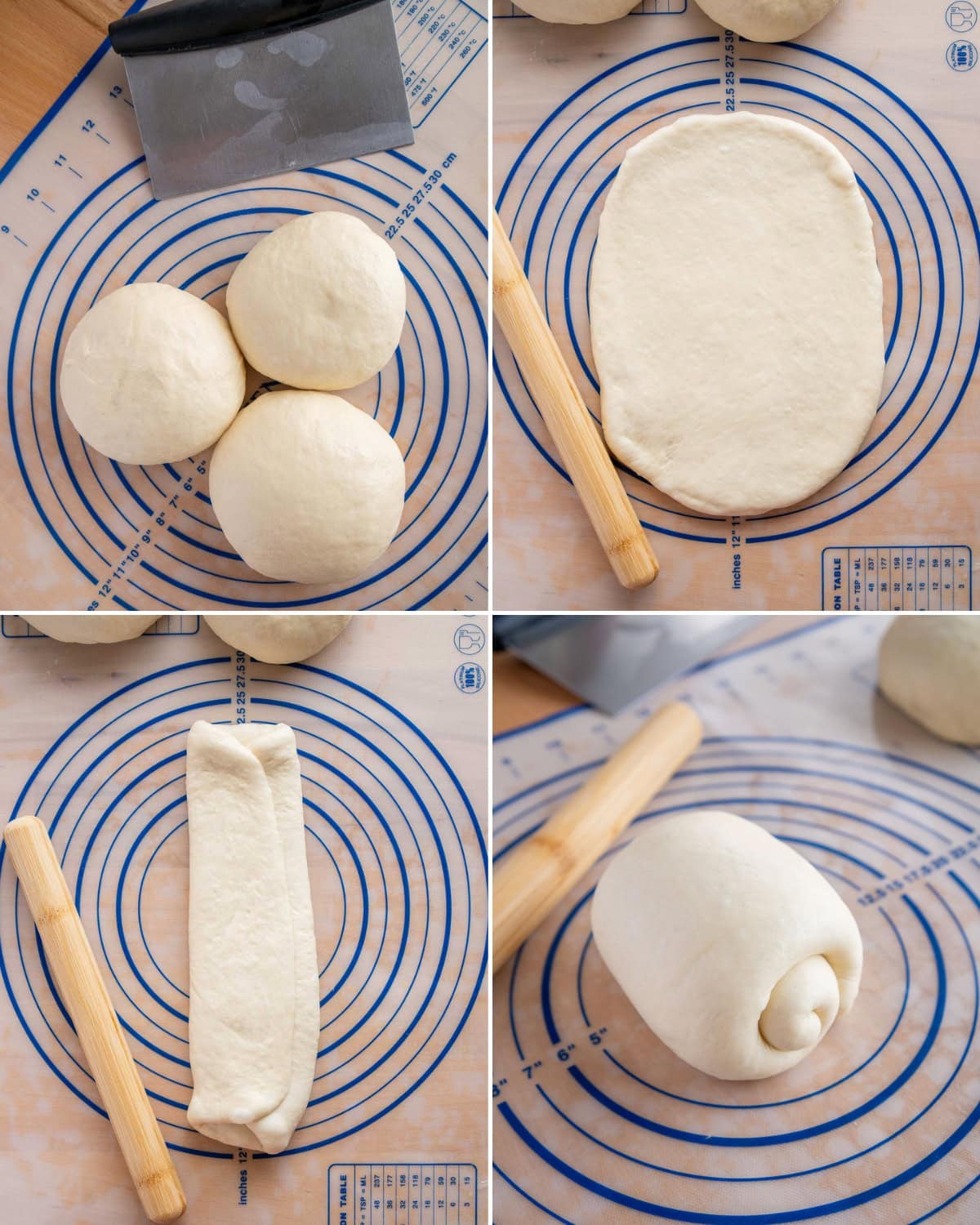
Step 5: Shape the loaf
Divide the risen dough into 3 equal portions. Shape each of them into a ball and allow them to rest for a few minutes (so the gluten relaxes).
Roll each dough ball out into a wide oval (about 1/2″ thick). Fold the left and right edges inward, then gently roll the piece back out to 1/2″ thick.
Then roll this rectangle of dough into a tight log.
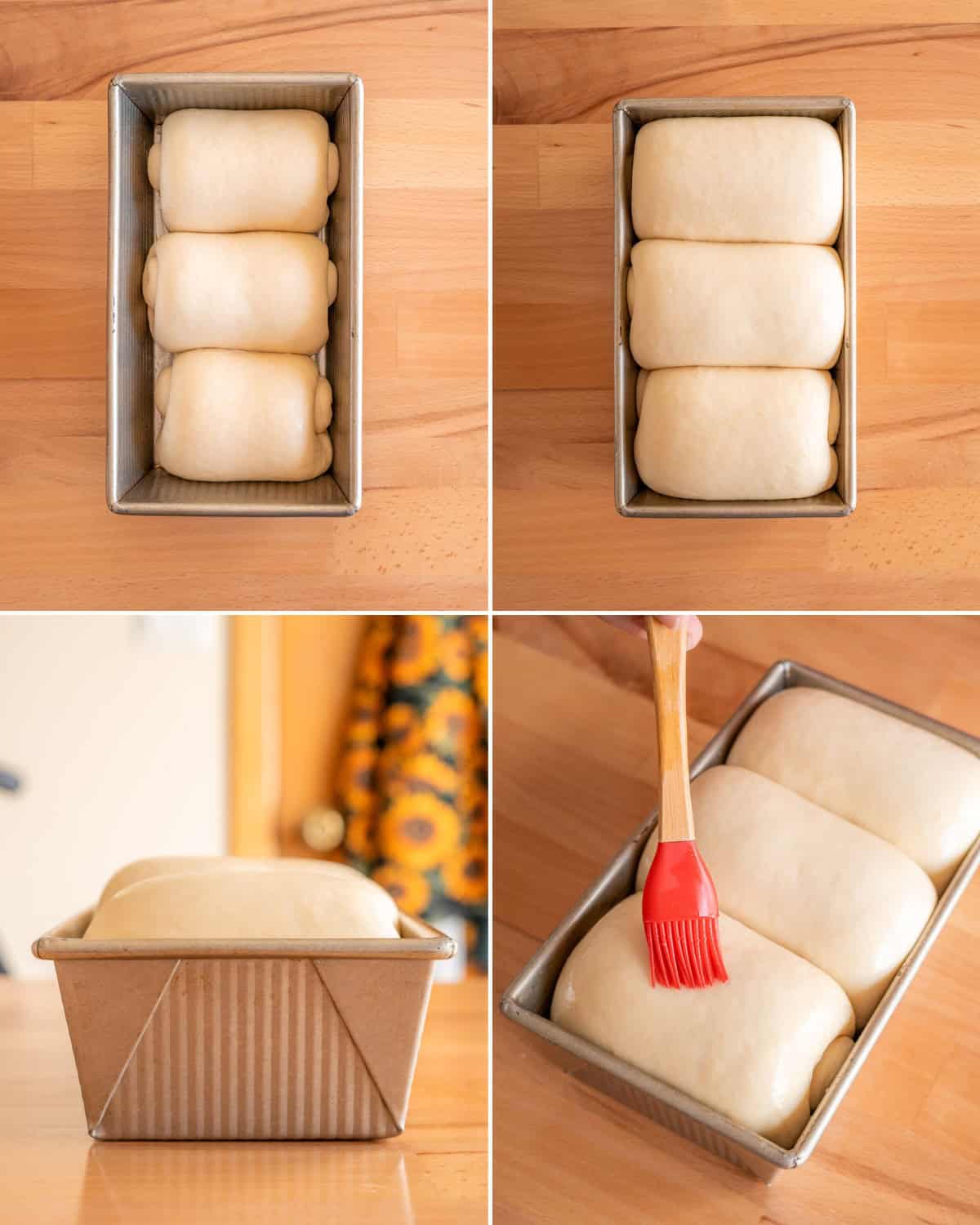
Step 6: Final rise and bake
Transfer the 3 dough logs into a greased loaf pan. Cover and allow to rise until doubled in size — it should be cresting over the top edge of the tin. (This will help to make sure it comes out super fluffy.) I usually let it rise for a full hour.
Brush the dough with a vegan egg wash mixture and bake until golden brown. Tent the top of the loaf loosely with aluminum foil if it appears to be getting dark a little too fast.
Let the loaf cool before slicing into it.

Sarah’s Recipe Tips
- Use a soy milk with minimal ingredients. I like to use the plain unsweetened soy milk by West Life or Trader Joe’s for all of my baking. Both of these contain only two ingredients (water and soybeans), so they lend the most neutral flavor and predictable results. Other brands of soy milk can be used, but they may impact the flavor a bit.
- Add more flour as needed. Working with dough is an intuitive process, and the texture of the dough is impacted by so many factors! Even the brand of flour can make a difference. If it is seeming overly sticky or soft while kneading, please feel free to work in extra flour until you achieve a soft yet elastic dough that bounces back when poked.
- Be generous with rising time. Make sure to let the shaped loaf rise until it is cresting slightly over the top edge of the loaf tin. This is key to making sure the bread is extra squishy, soft and fluffy. Usually this takes my dough about 1 hour, though it can take longer if the kitchen is chilly.
- Let the loaf cool. This might be the hardest part! I know it’s tempting to slice into the loaf while it’s fresh out of the oven, but at this point it’s still cooking internally. Let it cool for at least 45 minutes — otherwise you risk a gummy, undercooked texture that is hard to salvage.
How to Store Vegan Milk Bread
Bread can be stored in an airtight container on the counter for 2-3 days.
It can also be frozen in an airtight container — this is what I do! I like to slice it first and keep the slices in a freezer bag. (Press out as much of the air as you can before freezing to keep ice crystals from forming.) Individual slices can then be heated quickly in a toaster, or you can thaw the whole loaf first.
Serving Suggestions
- Vegan egg salad. My mom always used to pack me egg salad sandwiches on white bread for lunch. Now I love to pile this milk bread high with my eggy tofu salad whenever I’m craving a bite of nostalgia.
- Classic PB&Js. I don’t know about you, but the PB&Js I remember from my childhood were always on soft and squishy Wonder Bread. This vegan milk bread is the elevated version of that!
- Grilled cheeses. This bread is perfect spread with a little vegan butter and pan-toasted. It browns beautifully and becomes perfectly crisp while staying tender on the inside.
- French toast. Cut into nice thick slices for the most epic, restaurant-caliber vegan French toast.

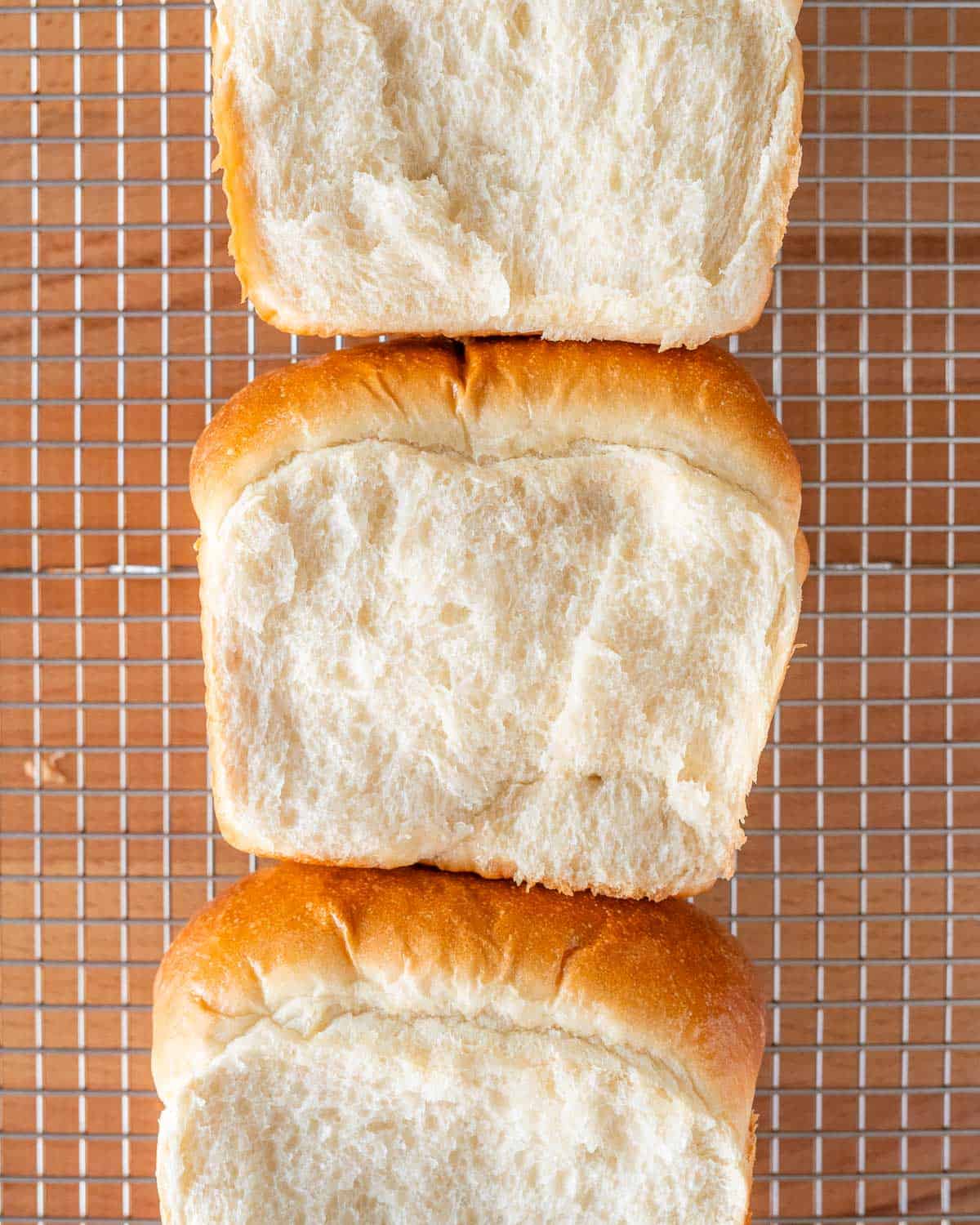
FAQ & Troubleshooting
Can I make this milk bread recipe by hand (without a mixer)?
Yes, of course! It will just take a little extra time and elbow grease to knead the dough. Also, because you are working the butter into the dough last, the kneading process starts out a little messier/greasier than it would with other types of dough. A bench scraper can be really useful to unstick dough from your surface at the beginning of the kneading process.
Can I make this recipe with other types of plant milk besides soy milk?
Yes, but the texture won’t be quite as nice. The protein and fats in soy milk really make it the perfect substitute for regular dairy milk in this recipe. Other types (especially thinner, more watery ones like almond milk) won’t lend the same degree of richness to the dough, but they should still work ok.
More Bread Recipes
- Garlic Herb Pull-Apart Bread (Vegan)
- Beginner Sourdough Loaf
- Easy Double Chocolate Vegan Banana Bread

Vegan Milk Bread
Equipment
- Small pot/pan & spatula to make the tangzhong
- stand mixer (recommended)
- Large mixing bowl and wooden spoon (if you don't own a stand mixer)
- Rolling Pin
- Loaf tin (9×5" recommended)
- pastry brush
Ingredients
Tangzhong
- 2 tablespoons bread flour
- 1/2 cup water
Milk Bread Dough
- 1 cup unsweetened plain soy milk room temperature or slightly warm
- 2 1/4 teaspoons active dry yeast 1 standard packet
- 3 tablespoons granulated sugar
- 1 teaspoon salt
- 3 1/2 cups bread flour
- 1/4 cup softened vegan butter cut into pieces
Vegan "Egg" Wash
- 1 tablespoon soy milk
- 1 scant tablespoon granulated sugar
Instructions
Prepare the Tangzhong
- In a small pan, stir together 2 tablespoons bread flour and 1/2 cup water to remove any lumps.
- Heat mixture over medium-high heat, stirring constantly, until it thickens to a paste consistency. (A flexible rubber spatula works best for this.)
- Remove from heat and allow to cool while you prepare other ingredients.
Mix the Vegan Milk Bread Dough
- In the bowl of a stand mixer, add soy milk. Whisk in the yeast and allow to proof for about 5 minutes, or until foamy.
- Add the sugar, salt, tangzhong, and bread flour. Use the paddle attachment to bring everything together into a shaggy dough. (If working by hand, use a wooden spoon or spatula to mix the ingredients together.)
- To knead with stand mixer (recommended): Add the butter a few pieces at a time and continue to mix with the paddle attachment on medium speed until the butter is roughly incorporated. The dough may still look a little shaggy at this point.Now switch out the paddle for the dough hook attachment and knead on medium speed until the dough is smooth, elastic, and uniform in texture (with no visible streaks of butter).If the dough seems overly soft or tacky, sprinkle in extra flour 1 tablespoon at a time as needed. The entire process of kneading with the stand mixer should take about 6-8 minutes.
- To knead by hand: Turn the dough out onto a lightly-floured surface. Distribute a few pieces of the softened butter across the dough and knead to incorporate. Sprinkle on extra flour as needed, if the dough is sticking excessively to your hands or your work surface — but avoid working in too much flour. A bench scraper is also useful to scrape up any dough sticking to your work surface. Keep adding a few more pieces of the butter at a time, kneading until it is incorporated. Repeat the process until all the butter has been added and the dough is smooth, elastic, and uniform in texture.The entire process of kneading by hand can take up to 15-20 minutes.
Rise the Dough
- Shape the dough into a ball and transfer it to a lightly-greased bowl. Cover it with a damp kitchen towel, plastic wrap, or even an upside-down plate to keep it from drying out.
- Let the dough rise in a warm spot for about 1 hour, or until doubled in volume. It will typically only take 1 hour, but it can process slower if it is very chilly in your kitchen — up to 1.5 hours.
Make the Vegan Egg Wash
- Mix together 1 tablespoon sugar and 1 tablespoon soy milk in a small, microwave-safe bowl or measuring cup. Microwave in 10-15 second bursts until the mixture begins to bubble and the sugar dissolves. Give this a stir. Cover loosely and set aside to cool.
Shape the Loaf
- Lightly grease a standard loaf tin. (9×5” works best, though it can also be made in an 8×4").
- Punch down the risen dough and turn it out onto a clean work surface.
- Divide the dough into 3 parts of roughly equal size. (You can use a digital scale for precision.)
- Shape each piece into a ball, then cover and allow to rest for about 10 minutes. This will give the gluten a moment to relax. (You can cover with the same damp towel or piece of plastic wrap used earlier. Or you can simply turn the bowl upside-down to cover the dough balls.)
- With a rolling pin, roll each ball of dough out into a wide oval shape about 1/2” thick. Fold both edges in toward the center, with one edge overlapping the other – like a letter fold, but along the long edge. (Consult the procedure photos for reference.) Then with the rolling pin, roll gently to widen the dough slightly and roll the piece back to roughly 1/2” thickness.
- Starting at the edge closest to you, tightly roll the dough into a log. Repeat with the remaining 2 pieces of dough.
- Transfer the three logs into the greased loaf tin, seam sides down.
- Lightly cover the loaf tin and allow to rise in a warm spot for about 1 hour, or until the dough is just cresting over the top edge of the loaf tin. Again — the exact time will vary depending on the temperature of your room. Near the end of the rising time, preheat oven to 350°F.
- Lightly brush the top of the loaf with the vegan egg wash mixture prepared earlier. Try to brush it on as evenly as possible so the loaf browns evenly.
Bake the Vegan Milk Bread
- Bake for 25-30 minutes, or until golden brown. (If it appears to be browning too quickly, loosely tent it with a sheet of aluminum foil.)
- Allow the loaf to cool in the tin for about 5 minutes before transferring it to a wire cooling rack. The interior of the loaf is still cooking once it comes out of the oven, so I recommend allowing it to cool fully before slicing — otherwise you risk a gummy texture.

This is literally the best bread I’ve ever had. I can use it for sandwiches or just take bites out of the fresh loaf. It’s so fluffy; I didn’t think this texture was even possible to achieve with plant-based ingredients!
The instructions are confusing. Step 1 of Mix the Vegan Milk Bread Dough says to combine soy milk and water, but water isn’t listed in that section of ingredients. Also, at what point do you add the tangzhong? Thanks.
It’s all there in the recipe card now! 👍
Sarah, I love your recipes, videos, and website. You are such an amazing source of support and inspiration since I began the journey into the WFPB lifestyle. Your holiday YouTube video was so helpful in so many ways. I also lost a beloved parent in 2016. As a fellow melancholy being I the kitchen has always been a favorite therapy. I hope you and Eric are well and that we will see you again soon. Blessings.
I just took the bread out of the oven and I‘m slightly disappointed. The dough looked fantastic during the final rise in the loaf tin, it had risen so well. However, when I brushed it and put it into the oven it became flatter and hasn’t risen again during baking. Of course, it can still taste great, but I would have loved for it to be super fluffy.
This came out so well! super fluffy and soft! I love it!!
I made it with spelt flour and coconut oil instead of vegan butter, I also added a bit of sourdough starter. Even with all of the changes it came out great, cannot stop eating it 😀
Dear Sarah, is there a way to make it from sourdough? Thank you! :o)
What temperature do you bake the bread at?
350°.